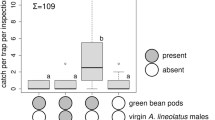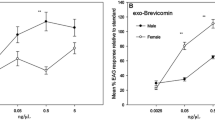Abstract
Volatiles from Ips duplicatus male hindgut extracts and aeration samples of spruce logs colonized by the virgin males were analyzed by coupled gas chromatography–mass spectrometry (GC-MS), coupled gas chromatography–electroantennographic detection (GC-EAD), and field trapping bioassays in Inner Mongolia, China. GC-MS analyses showed that males from nuptial chambers (for reproduction) produced hindgut volatile profiles similar to those of maturation feeding males from the nonreproductive galleries. The known aggregation pheromone components, ipsdienol (Id) and E-myrcenol (EM) are the major constituents of this blend, followed by several minor bark beetle-related compounds: 2-methyl-3-buten-2-ol, ipsenol, cis-verbenol, verbenone, 2-phenylethanol, myrtenol, and trans-myrtanol. The enantiomeric composition of the Id from the male hindgut extracts was determined to be a racemic mixture (50/50) by enantioselective GC. GC-EAD experiments indicated that I. duplicatus antennae from both sexes responded strongly not only to the known aggregation pheromone components, Id and EM, but also to the other minor conspecific-produced compounds. The strongest antennal response was elicited by the major pheromone component, Id, which was ca. 2–3 times higher than that elicited by the second component, EM. Electroantennogram dose-responses indicated that antennal response threshold to Id was approximately 100 times lower than that of EM. No synergistic effects between these occurred at peripheral level. A strong and repeatable EAD response was found to a trace compound (flame ionization detection undetectable) from both hindgut and aeration samples. The compound was identified as amitinol (At) based on the retention time and a further EAD analysis of a synthetic mixture. In the field trapping experiments, At increased the attraction of I. duplicatus to the traps baited with a binary blend of EM/Id (1:1) in a synergistic manner when tested at a low release rate (1:1:0.1) but had no effect on catches at the high release rate (1:1:1). This result suggests that At might be a part of the Chinese I. duplicatus aggregation pheromone system. The production ratios of EM/Id from the Inner Mongolian population (EM/Id ≈ 1:2.0–4) were twice as high as those reported from Europe (EM/Id ≈ 1:9), corresponding well with the differences in the optimal response ratios.





Similar content being viewed by others
References
Bakke, A. 1975. Aggregation pheromone in the bark beetle, Ips duplicatus (Sahlberg). Norw. J. Entomol. 22:67–69.
Byers, J. A., Schlyter, F., Birgersson, G., and Francke, W. 1990. E-myrcenol in Ips duplicatus : An aggregation pheromone component new for bark beetles. Experientia 46:1209–1211.
Francke, W., Heemann, V., Gerken, B., Renwick, J. A. A., and Vite, J. P. 1977. 2-EthyI-1,6- dioxaspiro[4.4]nonane, principal aggregation pheromone of Pityogenes chalcographus (L.). Naturwissenschaften 64:590–591.
Francke, W., Sauerwein, P., Vité, J. P., and Klimetzek, D. 1980. The pheromone bouquet of Ips amitinus. Naturwissenschaften 67:147–148.
Ivarsson, P., Schlyter, F., and Birgersson, G. 1993. Demonstration of de novo pheromone biosynthesis in Ips duplicatus (Coleoptera: Scolytidae): Inhibition of ipsdienol and E-myrcenol production by Compactin. Insect Biochem. Mol. Biol. 23:655–662.
Knizek, M., and Zahradnik, P. 1996. Mass outbreak of Ips duplicatus Sahlberg (Coleoptera: Scolytidae), p. 527, in J. Doe (ed.). XXth International Congress of Entomology, Firenze, Italy.
Krokene, P., and Solheim, H. 1996. Fungal associates of five bark beetle species colonizing Norway spruce. Can. J. For. Res. 26:2115–2122.
Lekander, B., Bejer-Pedersen, B., Kangas, E., and Bakke, A. 1977. The distribution of bark beetles in the Nordic countries. Acta Entomol. Fenn. 32:1–100.
Liu, G.-T., Liu, T., and Zhou, R. 1998. Prediction of occurrences and population tendency of Ips duplicatus Sahlb. by using Markov chain, pp. 258–260, in W.-D. Xu and G.-T. Liu (eds.). Study on Picea mongolica Forest Ecosystem in Baiyinaobao Natural Preserve, Inner Mongolia. China Forestry Publishing House, Beijing.
Macias-Samano, J. E., Borden, J. H., Pierce, H. D. J., Gries, R., and Gries, G. 1997. Aggregation pheromone of Pityokteines elegans. J. Chem. Ecol. 23:1333–1347.
Newcombe, R. 1998. Interval estimation for the difference between independent proportions: comparison of eleven methods. Stat. Med. 17:873–890.
Newcombe, R. 2006. Confidence intervals for proportions and related quantities. http://www.cardiff.ac.uk/medicine/epidemiology_statistics/research/statistics/newcombe/proportions. Accessed on 2 March 2006.
Pfeffer, A. 1995. Zentral- und westpaläarktische Borken- und Kernkäfer (Coleoptera: Scolytidae, Platypodidae). - Pro Entomologia, Naturhistorsches Museum Basel.
Poland, T. M., and Borden, J. H. 1997. Attraction of a bark beetle predator, Thanasimus undatulus (Coleoptera: Cleridae), to pheromones of the spruce beetle and two secondary bark beetles (Coleoptera: Scolytidae). J. Entomol. Soc. B.C. 94:35–42.
Savoie, A., Borden, J. H., Pierce, H. D. J., Gries, R., and Gries, G. 1998. Aggregation pheromone of Pityogenes knechteli and semiochemical-based interactions with three other bark beetles. J. Chem. Ecol. 24:321–337.
Schlyter, F., Byers, J. A., and Löfqvist, J. 1987. Attraction to pheromone sources of different quantity, quality, and spacing: Density-regulation mechanisms in bark beetle Ips typographus. J. Chem. Ecol. 13:1503–1524.
Schlyter, F., Birgersson, G., Byers, J. A., and Bakke, A. 1992. The aggregation pheromone of Ips duplicatus and its role in competitive interactions with Ips typographus (Coleoptera: Scolytidae). Chemoecology 3:103–112.
Schlyter, F., Svensson, M., Zhang, Q.-H., Knizek, M., Krokene, P., Ivarsson, P., and Birgersson, G. 2001a. A model for peak and width of signaling windows: Ips duplicatus and Chilo partellus pheromone component proportions—Does response have a wider window than production? J. Chem. Ecol. 27:1481–1512.
Schlyter, F., Zhang, Q.-H., Liu, G.-T., and Ji, L.-Z. 2001b. A successful case of pheromone mass-trapass trapping of the bark beetle Ips duplicatus in a forest island, analysed by 20-year time-series data. Integr. Pest Manag. Rev. 6:185–196.
Wang, G. C. 1992. Ips duplicatus Sahlb., pp. 620–622, in G. Xiao (ed.). Forest Insects of China. China Forestry Publishing House, Beijing.
Xu, W.-D., Zou, C.-J., and Liu, G.-T. 1998. The taxonomy and formation of Picea mongolica, in W.-D. Xu and G. T. Liu (eds.). Study on Picea mongolica Forest Ecosystem in Baiyinaobao Natural Preserve, Inner Mongolia. China Forestry Publishing House, Beijing.
Zhang, Q.-H., Schlyter, F., and Liu, G.-T. 1995. Spatial distribution, mortality and sex ratio of overwintering Ips duplicatus in a Picea mongolica reserve in Inner Mongolia, China with a diffusion model, pp. 109–122, in F. P. Hain, S. S. Salom, W. F. Ravlin, T. L. Payne, and K. F. Raffa (eds.). Behavior, Population Dynamics and Control of Forefsst Insects. Ohio State University, OARDC, Wooster.
Zhang, Q.-H., Birgersson, G., Zhu, J. W., Löfstedt, C., Löfqvist, J., and Schlyter, F. 1999. Leaf volatiles from nonhost deciduous trees: Variation by tree species, season and temperature, and electrophysiological activity in Ips typographus. J. Chem. Ecol. 25:1923–1943.
Zhang, Q.-H., Birgersson, G., Schlyter, F., and Chen, G.-F. 2000. Pheromone components in the larch bark beetle, Ips cembrae, from China: Quantitative variation among attack phases and individuals. J. Chem. Ecol. 26:841–858.
Zhang, Q.-H., Liu, G.-T., Schlyter, F., Birgersson, G., Anderson, P., and Valeur, P. 2001. Olfactory responses of Ips duplicatus from inner Mongolia, China to nonhost leaf and bark volatiles. J. Chem. Ecol. 27:995–1010.
Zhang, Q.-H., Schlyter, F., Chen, G., and Wang, Y. 2007. Electrophysiological and behavioral responses of Ips subelongatus to semiochemicals from its hosts, nonhosts and conspecifics in China. J. Chem. Ecol. 33:391–404.
Acknowledgements
We thank Dr. F.-M. Yan, Beijing University, China, for his careful shipment of the live beetles; Dr. S. R. Hill for helpful comments on the manuscript; and Ms. E. Marling for help in the preparation of hindgut extracts for enantioselective analysis. The permission to “thin” a spruce stand at Björnstorp Estate for bark beetle breeding is highly appreciated. This study was supported by grants from SJFR (No. 23.0521/96; No. 24.0293/98) and FORMAS (230-2005-1778) and an EU-INCO project (CT 98-0151).
Author information
Authors and Affiliations
Corresponding author
Rights and permissions
About this article
Cite this article
Zhang, QH., Schlyter, F., Liu, GT. et al. Electrophysiological and Behavioral Responses of Ips duplicatus to Aggregation Pheromone in Inner Mongolia, China: Amitinol as a Potential Pheromone Component. J Chem Ecol 33, 1303–1315 (2007). https://doi.org/10.1007/s10886-007-9320-3
Received:
Revised:
Accepted:
Published:
Issue Date:
DOI: https://doi.org/10.1007/s10886-007-9320-3




